Business Development: Strategies of FDI, Localization, and Logistics
VerifiedAdded on 2021/01/19
|5
|1822
|225
Report
AI Summary
This report delves into several key business concepts. It begins by examining the costs and benefits of Foreign Direct Investment (FDI) for both home and host countries, exploring its impact on employment, capital, and market dynamics. The report then contrasts localization and standardization strategies, providing examples of companies like KFC and McDonald's that effectively utilize these approaches to cater to diverse markets and build brand recognition. Next, the report addresses ethical and sustainable clothing, outlining a framework for companies to ensure ethical sourcing from suppliers, including adherence to living wages, worker rights, and safe working conditions. The report also explains fixed and floating exchange rate systems, highlighting their influence on international trade. Finally, it defines logistics and details the advantages of efficient logistics management, such as improved inventory control, marketing effects, and customer service. This assignment solution provides a comprehensive overview of these interconnected business development topics.
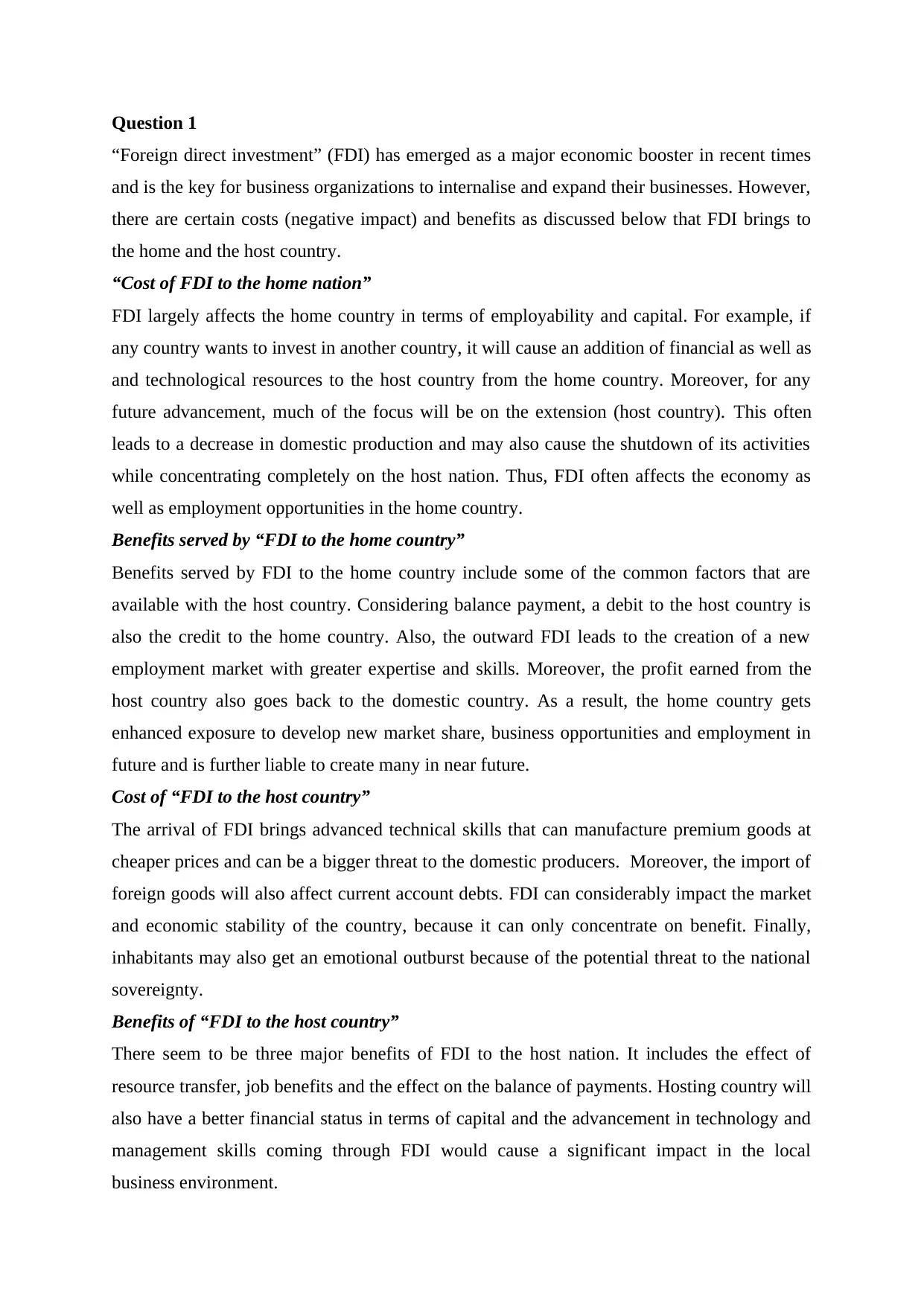
Question 1
“Foreign direct investment” (FDI) has emerged as a major economic booster in recent times
and is the key for business organizations to internalise and expand their businesses. However,
there are certain costs (negative impact) and benefits as discussed below that FDI brings to
the home and the host country.
“Cost of FDI to the home nation”
FDI largely affects the home country in terms of employability and capital. For example, if
any country wants to invest in another country, it will cause an addition of financial as well as
and technological resources to the host country from the home country. Moreover, for any
future advancement, much of the focus will be on the extension (host country). This often
leads to a decrease in domestic production and may also cause the shutdown of its activities
while concentrating completely on the host nation. Thus, FDI often affects the economy as
well as employment opportunities in the home country.
Benefits served by “FDI to the home country”
Benefits served by FDI to the home country include some of the common factors that are
available with the host country. Considering balance payment, a debit to the host country is
also the credit to the home country. Also, the outward FDI leads to the creation of a new
employment market with greater expertise and skills. Moreover, the profit earned from the
host country also goes back to the domestic country. As a result, the home country gets
enhanced exposure to develop new market share, business opportunities and employment in
future and is further liable to create many in near future.
Cost of “FDI to the host country”
The arrival of FDI brings advanced technical skills that can manufacture premium goods at
cheaper prices and can be a bigger threat to the domestic producers. Moreover, the import of
foreign goods will also affect current account debts. FDI can considerably impact the market
and economic stability of the country, because it can only concentrate on benefit. Finally,
inhabitants may also get an emotional outburst because of the potential threat to the national
sovereignty.
Benefits of “FDI to the host country”
There seem to be three major benefits of FDI to the host nation. It includes the effect of
resource transfer, job benefits and the effect on the balance of payments. Hosting country will
also have a better financial status in terms of capital and the advancement in technology and
management skills coming through FDI would cause a significant impact in the local
business environment.
“Foreign direct investment” (FDI) has emerged as a major economic booster in recent times
and is the key for business organizations to internalise and expand their businesses. However,
there are certain costs (negative impact) and benefits as discussed below that FDI brings to
the home and the host country.
“Cost of FDI to the home nation”
FDI largely affects the home country in terms of employability and capital. For example, if
any country wants to invest in another country, it will cause an addition of financial as well as
and technological resources to the host country from the home country. Moreover, for any
future advancement, much of the focus will be on the extension (host country). This often
leads to a decrease in domestic production and may also cause the shutdown of its activities
while concentrating completely on the host nation. Thus, FDI often affects the economy as
well as employment opportunities in the home country.
Benefits served by “FDI to the home country”
Benefits served by FDI to the home country include some of the common factors that are
available with the host country. Considering balance payment, a debit to the host country is
also the credit to the home country. Also, the outward FDI leads to the creation of a new
employment market with greater expertise and skills. Moreover, the profit earned from the
host country also goes back to the domestic country. As a result, the home country gets
enhanced exposure to develop new market share, business opportunities and employment in
future and is further liable to create many in near future.
Cost of “FDI to the host country”
The arrival of FDI brings advanced technical skills that can manufacture premium goods at
cheaper prices and can be a bigger threat to the domestic producers. Moreover, the import of
foreign goods will also affect current account debts. FDI can considerably impact the market
and economic stability of the country, because it can only concentrate on benefit. Finally,
inhabitants may also get an emotional outburst because of the potential threat to the national
sovereignty.
Benefits of “FDI to the host country”
There seem to be three major benefits of FDI to the host nation. It includes the effect of
resource transfer, job benefits and the effect on the balance of payments. Hosting country will
also have a better financial status in terms of capital and the advancement in technology and
management skills coming through FDI would cause a significant impact in the local
business environment.
Paraphrase This Document
Need a fresh take? Get an instant paraphrase of this document with our AI Paraphraser
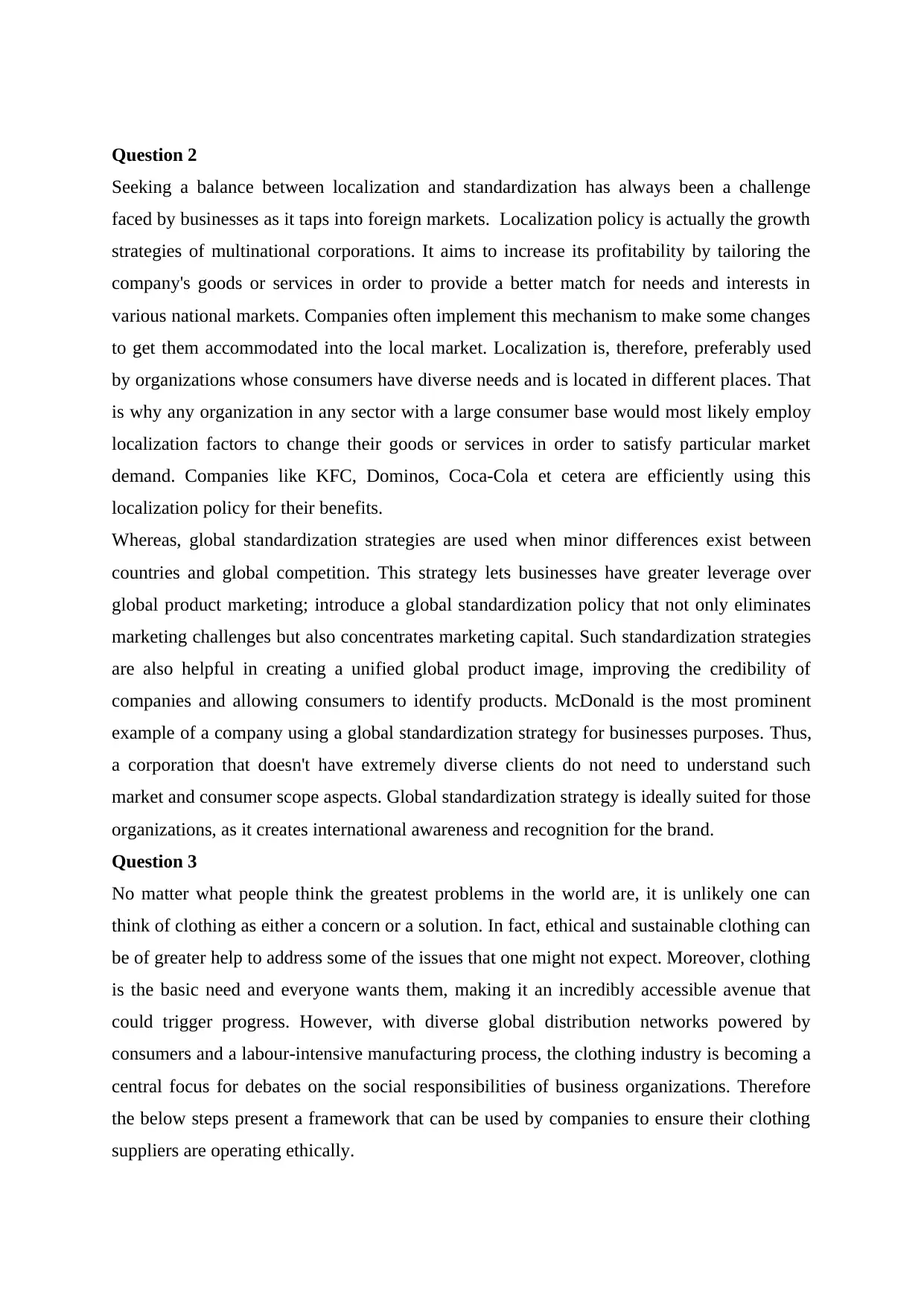
Question 2
Seeking a balance between localization and standardization has always been a challenge
faced by businesses as it taps into foreign markets. Localization policy is actually the growth
strategies of multinational corporations. It aims to increase its profitability by tailoring the
company's goods or services in order to provide a better match for needs and interests in
various national markets. Companies often implement this mechanism to make some changes
to get them accommodated into the local market. Localization is, therefore, preferably used
by organizations whose consumers have diverse needs and is located in different places. That
is why any organization in any sector with a large consumer base would most likely employ
localization factors to change their goods or services in order to satisfy particular market
demand. Companies like KFC, Dominos, Coca-Cola et cetera are efficiently using this
localization policy for their benefits.
Whereas, global standardization strategies are used when minor differences exist between
countries and global competition. This strategy lets businesses have greater leverage over
global product marketing; introduce a global standardization policy that not only eliminates
marketing challenges but also concentrates marketing capital. Such standardization strategies
are also helpful in creating a unified global product image, improving the credibility of
companies and allowing consumers to identify products. McDonald is the most prominent
example of a company using a global standardization strategy for businesses purposes. Thus,
a corporation that doesn't have extremely diverse clients do not need to understand such
market and consumer scope aspects. Global standardization strategy is ideally suited for those
organizations, as it creates international awareness and recognition for the brand.
Question 3
No matter what people think the greatest problems in the world are, it is unlikely one can
think of clothing as either a concern or a solution. In fact, ethical and sustainable clothing can
be of greater help to address some of the issues that one might not expect. Moreover, clothing
is the basic need and everyone wants them, making it an incredibly accessible avenue that
could trigger progress. However, with diverse global distribution networks powered by
consumers and a labour-intensive manufacturing process, the clothing industry is becoming a
central focus for debates on the social responsibilities of business organizations. Therefore
the below steps present a framework that can be used by companies to ensure their clothing
suppliers are operating ethically.
Seeking a balance between localization and standardization has always been a challenge
faced by businesses as it taps into foreign markets. Localization policy is actually the growth
strategies of multinational corporations. It aims to increase its profitability by tailoring the
company's goods or services in order to provide a better match for needs and interests in
various national markets. Companies often implement this mechanism to make some changes
to get them accommodated into the local market. Localization is, therefore, preferably used
by organizations whose consumers have diverse needs and is located in different places. That
is why any organization in any sector with a large consumer base would most likely employ
localization factors to change their goods or services in order to satisfy particular market
demand. Companies like KFC, Dominos, Coca-Cola et cetera are efficiently using this
localization policy for their benefits.
Whereas, global standardization strategies are used when minor differences exist between
countries and global competition. This strategy lets businesses have greater leverage over
global product marketing; introduce a global standardization policy that not only eliminates
marketing challenges but also concentrates marketing capital. Such standardization strategies
are also helpful in creating a unified global product image, improving the credibility of
companies and allowing consumers to identify products. McDonald is the most prominent
example of a company using a global standardization strategy for businesses purposes. Thus,
a corporation that doesn't have extremely diverse clients do not need to understand such
market and consumer scope aspects. Global standardization strategy is ideally suited for those
organizations, as it creates international awareness and recognition for the brand.
Question 3
No matter what people think the greatest problems in the world are, it is unlikely one can
think of clothing as either a concern or a solution. In fact, ethical and sustainable clothing can
be of greater help to address some of the issues that one might not expect. Moreover, clothing
is the basic need and everyone wants them, making it an incredibly accessible avenue that
could trigger progress. However, with diverse global distribution networks powered by
consumers and a labour-intensive manufacturing process, the clothing industry is becoming a
central focus for debates on the social responsibilities of business organizations. Therefore
the below steps present a framework that can be used by companies to ensure their clothing
suppliers are operating ethically.
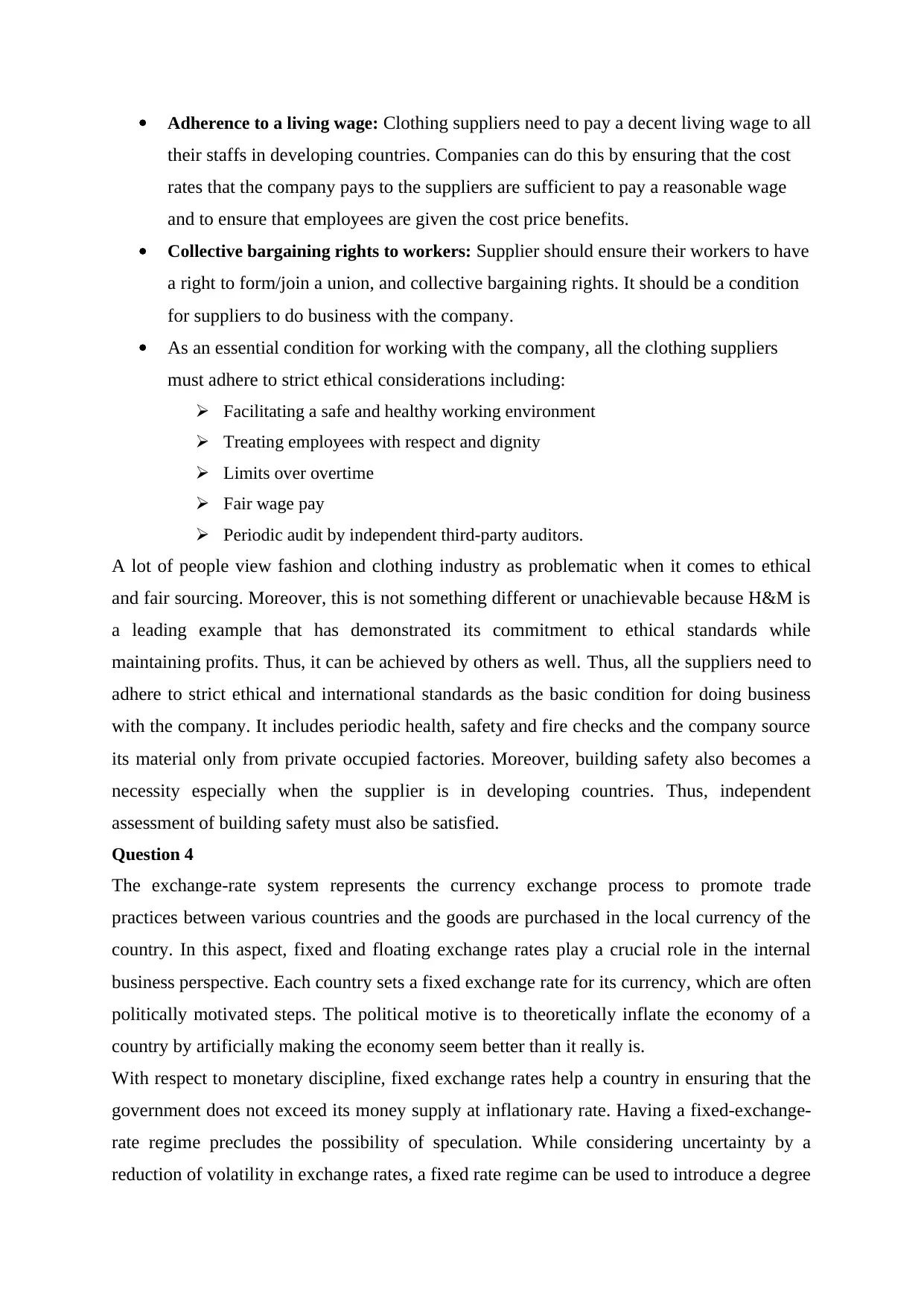
Adherence to a living wage: Clothing suppliers need to pay a decent living wage to all
their staffs in developing countries. Companies can do this by ensuring that the cost
rates that the company pays to the suppliers are sufficient to pay a reasonable wage
and to ensure that employees are given the cost price benefits.
Collective bargaining rights to workers: Supplier should ensure their workers to have
a right to form/join a union, and collective bargaining rights. It should be a condition
for suppliers to do business with the company.
As an essential condition for working with the company, all the clothing suppliers
must adhere to strict ethical considerations including:
Facilitating a safe and healthy working environment
Treating employees with respect and dignity
Limits over overtime
Fair wage pay
Periodic audit by independent third-party auditors.
A lot of people view fashion and clothing industry as problematic when it comes to ethical
and fair sourcing. Moreover, this is not something different or unachievable because H&M is
a leading example that has demonstrated its commitment to ethical standards while
maintaining profits. Thus, it can be achieved by others as well. Thus, all the suppliers need to
adhere to strict ethical and international standards as the basic condition for doing business
with the company. It includes periodic health, safety and fire checks and the company source
its material only from private occupied factories. Moreover, building safety also becomes a
necessity especially when the supplier is in developing countries. Thus, independent
assessment of building safety must also be satisfied.
Question 4
The exchange-rate system represents the currency exchange process to promote trade
practices between various countries and the goods are purchased in the local currency of the
country. In this aspect, fixed and floating exchange rates play a crucial role in the internal
business perspective. Each country sets a fixed exchange rate for its currency, which are often
politically motivated steps. The political motive is to theoretically inflate the economy of a
country by artificially making the economy seem better than it really is.
With respect to monetary discipline, fixed exchange rates help a country in ensuring that the
government does not exceed its money supply at inflationary rate. Having a fixed-exchange-
rate regime precludes the possibility of speculation. While considering uncertainty by a
reduction of volatility in exchange rates, a fixed rate regime can be used to introduce a degree
their staffs in developing countries. Companies can do this by ensuring that the cost
rates that the company pays to the suppliers are sufficient to pay a reasonable wage
and to ensure that employees are given the cost price benefits.
Collective bargaining rights to workers: Supplier should ensure their workers to have
a right to form/join a union, and collective bargaining rights. It should be a condition
for suppliers to do business with the company.
As an essential condition for working with the company, all the clothing suppliers
must adhere to strict ethical considerations including:
Facilitating a safe and healthy working environment
Treating employees with respect and dignity
Limits over overtime
Fair wage pay
Periodic audit by independent third-party auditors.
A lot of people view fashion and clothing industry as problematic when it comes to ethical
and fair sourcing. Moreover, this is not something different or unachievable because H&M is
a leading example that has demonstrated its commitment to ethical standards while
maintaining profits. Thus, it can be achieved by others as well. Thus, all the suppliers need to
adhere to strict ethical and international standards as the basic condition for doing business
with the company. It includes periodic health, safety and fire checks and the company source
its material only from private occupied factories. Moreover, building safety also becomes a
necessity especially when the supplier is in developing countries. Thus, independent
assessment of building safety must also be satisfied.
Question 4
The exchange-rate system represents the currency exchange process to promote trade
practices between various countries and the goods are purchased in the local currency of the
country. In this aspect, fixed and floating exchange rates play a crucial role in the internal
business perspective. Each country sets a fixed exchange rate for its currency, which are often
politically motivated steps. The political motive is to theoretically inflate the economy of a
country by artificially making the economy seem better than it really is.
With respect to monetary discipline, fixed exchange rates help a country in ensuring that the
government does not exceed its money supply at inflationary rate. Having a fixed-exchange-
rate regime precludes the possibility of speculation. While considering uncertainty by a
reduction of volatility in exchange rates, a fixed rate regime can be used to introduce a degree
⊘ This is a preview!⊘
Do you want full access?
Subscribe today to unlock all pages.

Trusted by 1+ million students worldwide
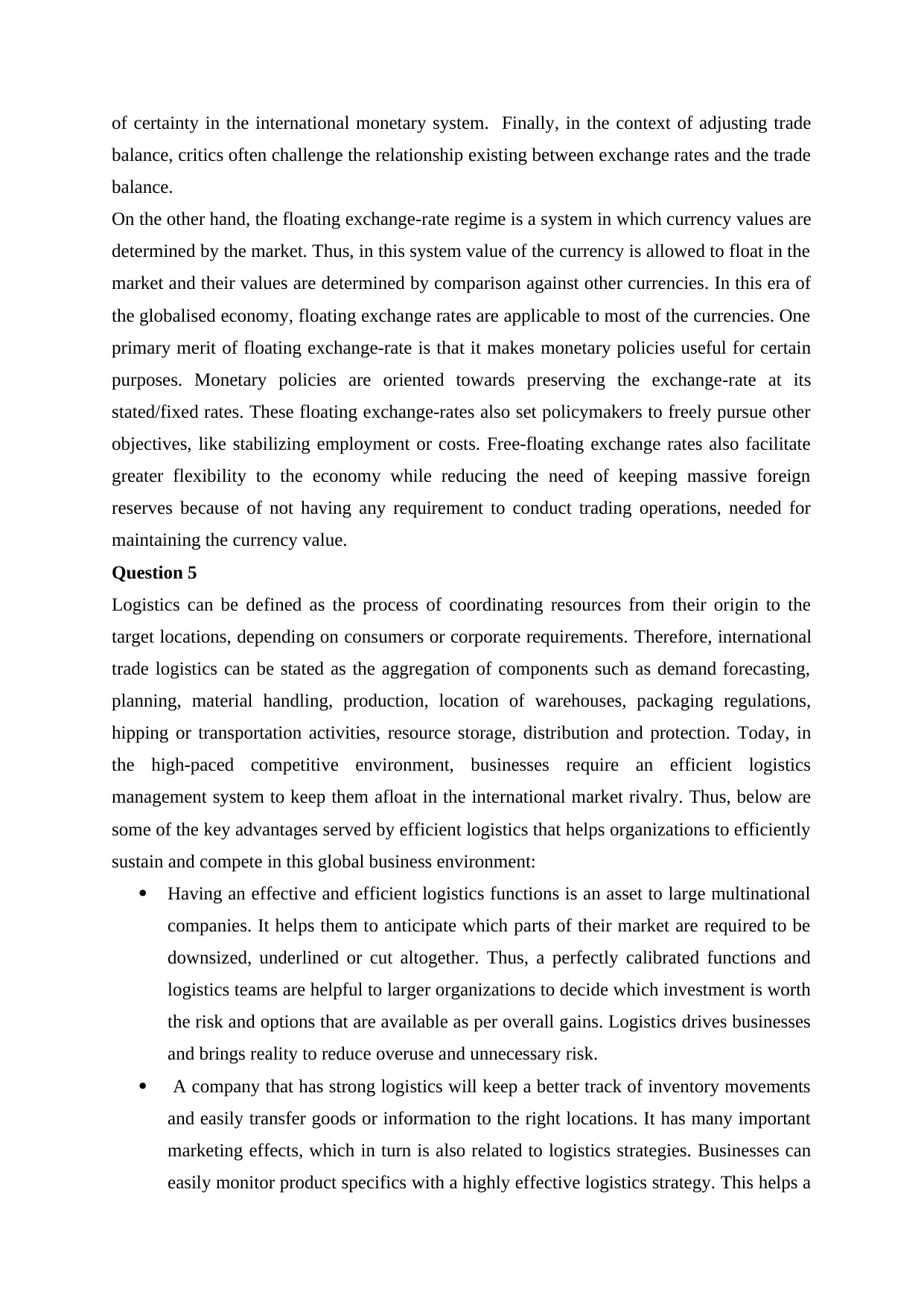
of certainty in the international monetary system. Finally, in the context of adjusting trade
balance, critics often challenge the relationship existing between exchange rates and the trade
balance.
On the other hand, the floating exchange-rate regime is a system in which currency values are
determined by the market. Thus, in this system value of the currency is allowed to float in the
market and their values are determined by comparison against other currencies. In this era of
the globalised economy, floating exchange rates are applicable to most of the currencies. One
primary merit of floating exchange-rate is that it makes monetary policies useful for certain
purposes. Monetary policies are oriented towards preserving the exchange-rate at its
stated/fixed rates. These floating exchange-rates also set policymakers to freely pursue other
objectives, like stabilizing employment or costs. Free-floating exchange rates also facilitate
greater flexibility to the economy while reducing the need of keeping massive foreign
reserves because of not having any requirement to conduct trading operations, needed for
maintaining the currency value.
Question 5
Logistics can be defined as the process of coordinating resources from their origin to the
target locations, depending on consumers or corporate requirements. Therefore, international
trade logistics can be stated as the aggregation of components such as demand forecasting,
planning, material handling, production, location of warehouses, packaging regulations,
hipping or transportation activities, resource storage, distribution and protection. Today, in
the high-paced competitive environment, businesses require an efficient logistics
management system to keep them afloat in the international market rivalry. Thus, below are
some of the key advantages served by efficient logistics that helps organizations to efficiently
sustain and compete in this global business environment:
Having an effective and efficient logistics functions is an asset to large multinational
companies. It helps them to anticipate which parts of their market are required to be
downsized, underlined or cut altogether. Thus, a perfectly calibrated functions and
logistics teams are helpful to larger organizations to decide which investment is worth
the risk and options that are available as per overall gains. Logistics drives businesses
and brings reality to reduce overuse and unnecessary risk.
A company that has strong logistics will keep a better track of inventory movements
and easily transfer goods or information to the right locations. It has many important
marketing effects, which in turn is also related to logistics strategies. Businesses can
easily monitor product specifics with a highly effective logistics strategy. This helps a
balance, critics often challenge the relationship existing between exchange rates and the trade
balance.
On the other hand, the floating exchange-rate regime is a system in which currency values are
determined by the market. Thus, in this system value of the currency is allowed to float in the
market and their values are determined by comparison against other currencies. In this era of
the globalised economy, floating exchange rates are applicable to most of the currencies. One
primary merit of floating exchange-rate is that it makes monetary policies useful for certain
purposes. Monetary policies are oriented towards preserving the exchange-rate at its
stated/fixed rates. These floating exchange-rates also set policymakers to freely pursue other
objectives, like stabilizing employment or costs. Free-floating exchange rates also facilitate
greater flexibility to the economy while reducing the need of keeping massive foreign
reserves because of not having any requirement to conduct trading operations, needed for
maintaining the currency value.
Question 5
Logistics can be defined as the process of coordinating resources from their origin to the
target locations, depending on consumers or corporate requirements. Therefore, international
trade logistics can be stated as the aggregation of components such as demand forecasting,
planning, material handling, production, location of warehouses, packaging regulations,
hipping or transportation activities, resource storage, distribution and protection. Today, in
the high-paced competitive environment, businesses require an efficient logistics
management system to keep them afloat in the international market rivalry. Thus, below are
some of the key advantages served by efficient logistics that helps organizations to efficiently
sustain and compete in this global business environment:
Having an effective and efficient logistics functions is an asset to large multinational
companies. It helps them to anticipate which parts of their market are required to be
downsized, underlined or cut altogether. Thus, a perfectly calibrated functions and
logistics teams are helpful to larger organizations to decide which investment is worth
the risk and options that are available as per overall gains. Logistics drives businesses
and brings reality to reduce overuse and unnecessary risk.
A company that has strong logistics will keep a better track of inventory movements
and easily transfer goods or information to the right locations. It has many important
marketing effects, which in turn is also related to logistics strategies. Businesses can
easily monitor product specifics with a highly effective logistics strategy. This helps a
Paraphrase This Document
Need a fresh take? Get an instant paraphrase of this document with our AI Paraphraser
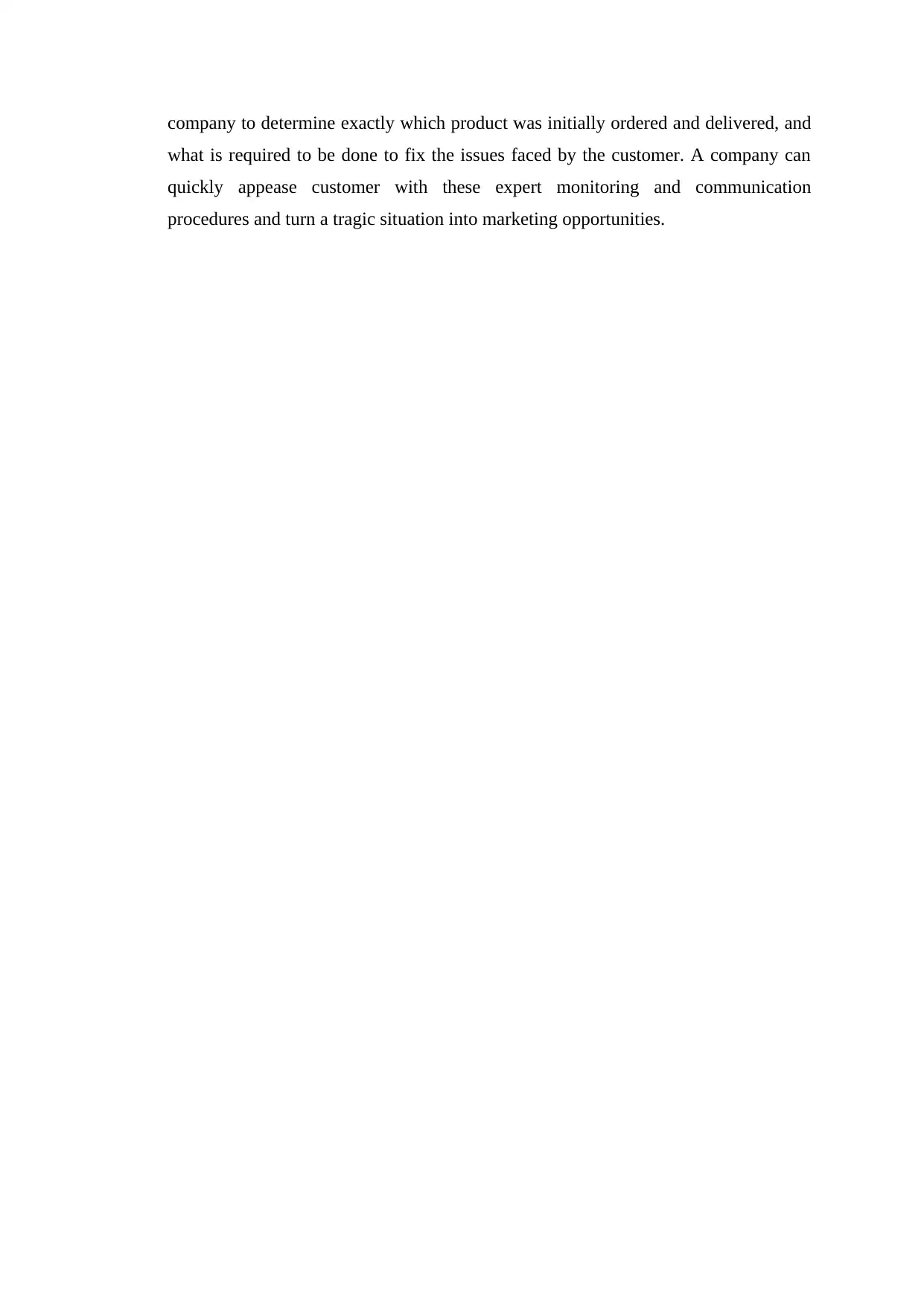
company to determine exactly which product was initially ordered and delivered, and
what is required to be done to fix the issues faced by the customer. A company can
quickly appease customer with these expert monitoring and communication
procedures and turn a tragic situation into marketing opportunities.
what is required to be done to fix the issues faced by the customer. A company can
quickly appease customer with these expert monitoring and communication
procedures and turn a tragic situation into marketing opportunities.
1 out of 5
Related Documents
Your All-in-One AI-Powered Toolkit for Academic Success.
+13062052269
info@desklib.com
Available 24*7 on WhatsApp / Email
![[object Object]](/_next/static/media/star-bottom.7253800d.svg)
Unlock your academic potential
Copyright © 2020–2025 A2Z Services. All Rights Reserved. Developed and managed by ZUCOL.




